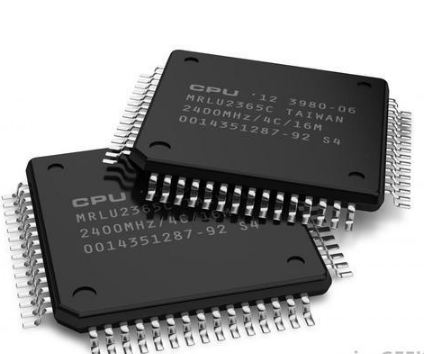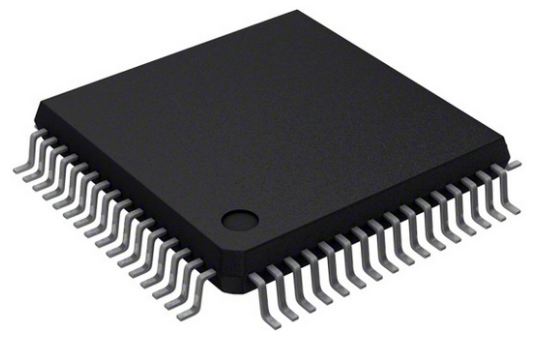Microprocessor
A microprocessor is an integrated circuit (IC) which performs the instructions and tasks involved in computer processing. It is a controlling unit of a micro-computer, fabricated on a small chip capable of performing Arithmetic Logic Unit (ALU) operations and communicating with the other devices connected to it. Microprocessor consists of an ALU, register array and a control unit.
ALU performs all arithmetic and logic operations on the data received from input devices or memory. Register array consists of a series of registers like accumulator (A, B, C , D etc) which acts as temporary fast access memory locations for data processing. Control unit on the other hand, controls the flow of instructions and data throughout the system.

Applications Of A Microprocessor
Microprocessor is used in:
- car automation
- Telecommunication and military application
- Radar
- Accounting systems and data acquisition systems
- Office automation
- Railway reservation and air reservation systems
- Entertaining system and games machine
- Biometric
- Complex Industrial controllers such as clocking systems
Advantages of Microprocessor
- It is capable of executing millions of instructions per second.
- They are usually very flexible since the same chip can be used for a number of applications by simply changing the instructions stored in the memory.
- They can be used to perform complex mathematical operations.
- It can transfer data between different memory locations at very high speed.
Disadvantages Of Microprocessor
- The microprocessor does not have any internal peripheral like ROM, RAM and other I/O devices.
- Physical overheating is also a common problem for microprocessors.
- Does not support floating point operations.
What You Need To Know About Microprocessor
- The microprocessor has very few numbers of internal registers and therefore, it has to rely on external storage. In this regard, all the memory operations are carried out using memory-based external commands.
- Microprocessor is the heart of computer system.
- The power consumption of microprocessor is high due to external components; therefore, it is not suitable to be used with devices running on stored power like batteries.
- The microprocessor uses CISC Von Neumann architecture where data and program are stored in the same memory module.
- Microprocessor is just a processor. Memory and I/O components have to be connected externally.
- The microprocessor circuit is large because memory and I/O has to be connected externally.
- Majority of microprocessors do not have power saving features.
- The cost of microprocessor based systems is high when compared with microcontroller based systems.
- The microprocessor cannot be used in compact systems.
- Microprocessor is relatively slower when compared to microcontroller. This is because the memory and I/O components are all external and therefore each instruction will require external operation.
- The microprocessor is used in desktops and personal computers.
- Core 2 duo, dual-core, and Intel Pentium series are some of the commonly used microprocessors.
- The design of microprocessor application takes more time when compared to that of microcontroller.
Also Read: Difference Between RISC And CISC
Microcontroller
A microcontroller is a compact integrated circuit designed to govern a specific operation in an embedded system like displaying microwave’s information, receiving remote signals etc. A typical microcontroller includes a processor, memory (RAM, ROM, EPROM), Serial ports, peripherals (timers, counters, input/output (I/O) peripherals on a single chip.
A microcontroller is embedded inside of a system to control a singular function in a device. It does this by interpreting data it receives from its I/O peripherals using its central processor. The temporal information that the microcontroller receives is stored in its data memory, where the processor accesses it and uses instructions stored in its program memory to decipher and apply the incoming data. It then uses its I/O peripherals to communicate and enact the appropriate action.

Application Of Microcontroller
Microcontrollers are used in:
- Mobile radio transceivers
- Medical devices
- Office machines
- Home appliances
- Robots
- Vending machines etc
Advantages Of Microcontroller
- It takes significantly less time to perform operations.
- With microcontroller, it is easy to use troubleshooting and systems maintain is simple.
- Microcontrollers are highly integrated and therefore, the size of the system is highly reduced. They can comfortably fit inside other devices.
- It is easy to interface additional RAM, ROM and I/O ports.
- Less costly to produce and consume less power.
Disadvantages Of Microcontroller
- It cannot interface high power directly device directly.
- It highly sophisticated when compared to microprocessor.
- It is only capable of executing a limited number of operations simultaneously.
What You Need To Know About Microcontroller
- The microcontroller has many registers for instruction execution. Fetching data and storing data require internal commands.
- Microprocessor is a heart of embedded system.
- The total power consumption of microcontroller is less and therefore, it is suitable to be used with devices running on stored power like batteries.
- The microcontroller uses Harvard architecture and RISC where data memory and program memory are stored separate.
- Microcontroller has external processor along with internal memory and I/O components.
- Given that memory and I/O are connected internally, the circuit is small.
- Majority of microcontroller have power saving features likes idle mode and power saving mode. This helps in reduction of power consumption.
- The cost of microcontroller based systems is low when compared with microprocessor based systems.
- The microcontroller can be used in compact system as it has a small size. It provides better and efficient technique in the compact system than the microprocessor.
- Given that components of a microcontroller are internal, therefore most of the operations are internal instructions, in this regard; the microcontroller is relatively fast in speed when compared to microprocessor.
- The microcontroller is used in embedded systems such as MP3 player, Television, Refrigerator, and washing machine etc.
- Microcontrollers are produced by many hardware manufacturer companies such as Motorola, Philips, Microchips, ATMEL etc.
- The design of microcontroller application takes relatively less time when compared to that of microprocessor. This is because, the interfacing between the peripheral devices and embedded programming will be very easy compared to the microprocessor.
Also Read: Difference Between Control Unit (CU) And Arithmetic Logic Unit (ALU)
Difference Between Microprocessor And Microcontroller In Tabular Form
| BASIS OF COMPARISON | MICROPROCESSOR | MICROCONTROLLER |
| Description | A microprocessor is a central processing unit used to perform tasks such as arithmetic and logic operations, system controlling and storing of data. | A microcontroller is a computer on a chip in which many support devices like RAM, ROM, timers, counters, I/O peripherals are fixed in IC. |
| Microprocessor is the heart of computer system. | Microprocessor is a heart of embedded system. | |
| Registers | It has very few numbers of internal registers and therefore, it has to rely on external storage. | It has many registers for instruction execution. |
| Power Consumption | The power consumption of microprocessor is high. | The total power consumption of microcontroller is less. |
| Suitability | It is not suitable to be used with devices running on stored power like batteries. | It is suitable to be used with devices running on stored power like batteries. |
| Architecture | It uses CISC Von Neumann architecture where data and program are stored in the same memory module. | It uses Harvard architecture and RISC where data memory and program memory are stored separate. |
| Constituents | It is just a processor. Memory and I/O components have to be connected externally. | It has external processor along with internal memory and I/O components. |
| Circuit Size | Circuit is large because memory and I/O has to be connected externally. | Given that memory and I/O are connected internally, the circuit is small. |
| Power Saving Features | They do not have power saving features. | They have power saving features likes idle mode and power saving mode. This helps in reduction of power consumption. |
| Cost | The cost of microprocessor based systems is high when compared with microcontroller based systems. | The cost of microcontroller based systems is low when compared with microprocessor based systems. |
| Use | It cannot be used in compact systems. | It can be used in compact system due to small size. |
| Speed | Microprocessor is relatively slower when compared to microcontroller. | The microcontroller is relatively fast in speed when compared to microprocessor. |
| Application | It is used in desktops and personal computers. | It is used in embedded systems such as MP3 player, Television, Refrigerator, and washing machine etc. |
| Examples | Core 2 duo, dual-core, and Intel Pentium series are some of the commonly used microprocessors. | Microcontrollers are produced by many hardware manufacturer companies such as Motorola, Philips, Microchips, ATMEL etc. |
| Design Time | The design of microprocessor application takes more time when compared to that of microcontroller. | The design of microcontroller application takes relatively less time when compared to that of microprocessor. |